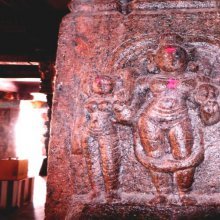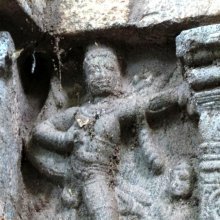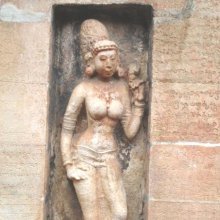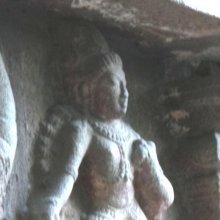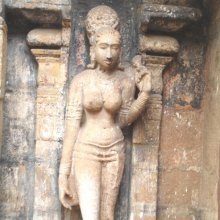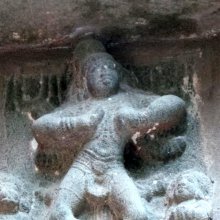Katakamukha, Kaṭakāmukha, Kataka-mukha: 3 definitions
Introduction:
Katakamukha means something in Hinduism, Sanskrit. If you want to know the exact meaning, history, etymology or English translation of this term then check out the descriptions on this page. Add your comment or reference to a book if you want to contribute to this summary article.
Images (photo gallery)
(+28 more images available)
In Hinduism
Natyashastra (theatrics and dramaturgy)
Source: Wisdom Library: Nāṭya-śāstraKaṭakāmukha (कटकामुख) is a variant spelling for Khaṭakāmukha, a Sanskrit technical term referring to a gesture (āṅgika) made with a ‘single hand’ (asaṃyuta), according to the Nāṭyaśāstra chapter 8.
Source: archive.org: The mirror of gesture (abhinaya-darpana)One of the Twenty-eight Single Hands (hasta):—Kaṭaka-mukha (opening in a link): the forefinger and middle finger are applied to the thumb. Usage: picking flowers, holding a pearl necklace or garland of flowers, drawing a bowslowly, distributing folded betel leaves, applying such thingsas musk or scent, speech, glancing.
According to another book: the thumb of the Kapittha handis thrown forward. This hand originated when Guha received instruction in archery from Śiva. Its sage is Bhārgava, itscolour coppery, its race Deva, its presiding deity Raghurāma.Usage: holding a pearl or flower garland or a fly-whisk, drawingout an arrow, holding out a mirror, reins, conveyance, breaking a twig, cleaning the teeth, picking flowers, distributing folded betel leaves, applying musk, embrace of harlots, drawing thebow, holding the discus, holdiag a fan, gold colour, Deva caste.
Note: The tip of the forefinger and the side of the middle finger are applied to the tip of the thumb, the third finger is bent beside the middle finger, and the little finger is also bent, but to a less degree. According to T. A. Gopinatha Rao, “HinduIconography,” Vol. I, pt. 1, description of terms, p. 16, this hand (syn. Siṃhakarṇa) in images is generally intended to receive the daily offering of a freshflower, and this is supported by the Ajaṇṭā usage. This hand is also used in teaching and is known to some iconographers, perhaps incorrectly, as Vitarka-mudrā.
Source: archive.org: Natya ShastraKaṭakāmukha (कटकामुख, “elephant-apple”).—A type of gesture (āṅgika) made with a single hand (asaṃyuta-hasta);—(Instructions): The ring-finger and the little finger of this Kapittha hand to be raised and bent.
(Uses): It is used to represent sacrifice, oblation, umbrella, drawing up reins, fan, holding a mirror, drawing [patterns], powdering, taking up big sticks, arranging a pearl necklace, wearing garlands, gathering the ends of clothes, churning, drawing out arrows, plucking flowers, wielding a long whip, drawing out a goad, a rope, and representing a woman.

Natyashastra (नाट्यशास्त्र, nāṭyaśāstra) refers to both the ancient Indian tradition (shastra) of performing arts, (natya—theatrics, drama, dance, music), as well as the name of a Sanskrit work dealing with these subjects. It also teaches the rules for composing Dramatic plays (nataka), construction and performance of Theater, and Poetic works (kavya).
See also (Relevant definitions)
Partial matches: Kataka, Mukha.
Ends with: Aralakatakamukha.
Full-text: Aralakatakamukha, Caturashra, Dundupha, Kataka-vardhana, Mushtikasvastika, Padapaviddhaka, Surya, Hasta, Asamyuta, Shuci, Samyutta-hastani, Pramada, Sucimukha.
Relevant text
Search found 4 books and stories containing Katakamukha, Kaṭakāmukha, Kataka-mukha, Kaṭaka-mukha; (plurals include: Katakamukhas, Kaṭakāmukhas, mukhas). You can also click to the full overview containing English textual excerpts. Below are direct links for the most relevant articles:
Abhinaya-darpana (English) (by Ananda Coomaraswamy)
Chapter 14 - Twenty-six Combined Hands
Plate XI - Single and Combined Hands < [Plates]
Gati in Theory and Practice (by Dr. Sujatha Mohan)
Gati in vehicles < [Chapter 3 - Application of gati in Dṛśya-kāvyas]
Description of Gati in Abhinayadarpaṇa < [Chapter 2 - Concept and technique of Gati]
Gati pertaining to Characters < [Chapter 3 - Application of gati in Dṛśya-kāvyas]
Natyashastra (English) (by Bharata-muni)
Chapter IX - Gestures of Major Limbs (aṅga)
Chapter XIII - Different Gaits (gati)
Part 4 - The Ancient Indian Drama in Practice < [Introduction, part 1]
Yaksha Gana < [September-October 1934]
